|
|
 |
Fiche d'espèce de Copépode |
|
|
Calanoida ( Ordre ) |
|
|
|
Clausocalanoidea ( Superfamille ) |
|
|
|
Aetideidae ( Famille ) |
|
|
|
Gaetanus ( Genre ) |
|
|
| |
Gaetanus pileatus Farran, 1903 (F,M) | |
| | | | | | | Syn.: | Gaetanus Caudani Canu, 1896 (? p.422, juv.M); Wolfenden, 1904 (p.132, figs.F, Rem.); 1905 a (p.8, fig.F); Pearson, 1906 (p.13, Rem.); A. Scott, 1909 (p.46, figs.F, Rem.); Giesbrecht & Schmeil, 1898 (p.33: Rem. juv. M); Pearson, 1906 (p.13); A. Scott, 1909 (p.46, figs.); Lysholm & Nordgaard, 1921 (p.14);
Gaetanus unicornis Esterly, 1906 a (p.57, figs.F); Wilson, 1936 c (p.90); Brodsky, 1950 (1967) (p.167, figs.F); Lee & al., 1971 (p.1150);
Gaetanus clarus Esterly, 1906 a (p.57, figs.M); Brodsky, 1950 (1967) (p.166, figs.M);
Gaetanus recticornis Wolfenden, 1911 (p.228, fig.F); C.B. Wilson, 1950 (p.233, figs.F);
Gaetanus kruppii : Sewell, 1947 (p.62, Rem.M, figs.M, no F) | | | | Ref.: | | | Farran, 1903 (p.16, Descr.F, figs.F); 1908 b (p.35, Rem.); Wolfenden, 1911 (p.229, figs.F, Rem.); With, 1915 (p.104, figs.F); Sars, 1925 (p.56, figs.F, M); Farran, 1926 (p.250); Sewell, 1929 (p.103, figs.juv., Rem.); Rose, 1933 a (p.100, figs.F,M); Farran, 1936 a (p.89); Jespersen, 1940 (p.20); Sewell, 1947 (p.56, 57, 59); Vervoort, 1952 e (p.3, figs.F,M); Tanaka, 1957 b (p.175, figs.F); Vervoort, 1963 b (p.132, Rem.); Paiva, 1963 (p.33); Owre & Foyo, 1967 (p.45, figs.F,M, Rem.); Tanaka & Omori, 1970 (p.141); Park, 1975 a (p.10, 13, 20, figs.F,M, Rem. p.21-23); 1978 (p.139, figs.F); Bradford & Jillett, 1980 (p.55, figs.F,M); Gardner & Szabo, 1982 (p.230, figs.F,M); Baessa de Aguiar, 1987 (p.44, figs.F, Rem.F); Markhaseva, 1996 (p.211, figs.F, ?M); Bradford-Grieve & al., 1999 (p.879, 922, figs.F); Boxshall & Halsey, 2004 (p.59: fig.F); Vives & Shmeleva, 2007 (p.583, figs.F,M, Rem.) | 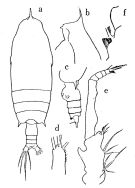 issued from : Tanaka O. in Publ. Seto Mar. Biol. Lab., 1957, 6 (2). [Fig.43, p.176]. Female (from Sagami): a, habitus (dorsal aspect); b, head (lateral aspect); c, last thoracic segment and urosome (lateral aspect); d, third inner lobe with 3 setae and a conical process of Mx1; e, Mxp.; f, first basal joint of P4, with 16 lamellous bristles on the inner margin. Nota Female: - Cephalic spine has a characteristic shape. - Last thoracic segment with lateral spines divergent, and extend to the middle of genital segment. - Abdomen 4-segmented ; segments and caudal rami proportional lengths 44 : 17 : 14 : 9 : 16 = 100. - Genital segment as long as wide, showing a sudden change in the continuity of the outline at the proximal 2/5 of the dorsal surface. - Caudal rami as long as wide. - A2 exopod about as long as endopod.. - Mx1 with 7 long and 2 short setae on outer lobe; 3rd inner lobe with 3 setae and a conical process (at apex fig.d). - Mxp with 1st basal segment about as long as the 2nd; 1st segment with a lamellous process with a rounded tip on posterior margin. - P1 exopod 2-segmented with no articulation between 1st and 2nd segments. - P2 exopod 3-segmented and endopod 2-segmented; the number of teeth on terminal spine of P2 to P4 with 20, 20, and 23 respectively. - P4 with coxa bearing about 16 lamellous bristles on the inner margin
|
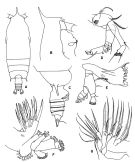 issued from : T. Park in Antarctic Res. Ser. Washington, 1978, 27. [p.140, Fig.23]. Female: A, habitus (dorsal); B, forehead (lateral); C, posterior part of metasome and urosome (right lateral side); D, A2; E, Md; F, Mx1; G, Mx2.
|
 issued from : T. Park in Antarctic Res. Ser. Washington, 1978, 27. [p.141, Fig.24]. Female: A, Mxp; B, P1; C, P2; D, P3; E, medial part of coxa of P4 (posterior). P1-3: legs (anterior).
|
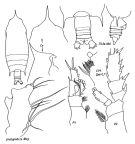 issued from : E.L. Markhaseva in Proc. Zool. Inst. RAN, St. Petersburg, 1996, 268. [p.213, Fig.168]. Female (from SE Pacif.). Ce: forehead (dorsal and lateral, respectively); CP4: coxopod of P4 (partial).
|
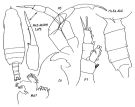 issued from : E.L. Markhaseva in Proc. Zool. Inst. RAN, St. Petersburg, 1996, 268. [p.214, Fig.169 ]. Male (from Indian: off NW Cocos island)
|
 issued from : T. Park in Bull. Mar. Sci., 1975, 25 (1). [p.21, Fig.6]. Female: A, B, forehead, lateral (showing a variability of the cephalic process). Male: C, forehead (lateral); D, posterior part of metasome and urosome (left side, lateral); E, figth legs (posterior); F, last two exopodal segments of left fifth leg (medial).
|
 issued from : J.M. Bradford & J.B. Jillett in Mem. N.Z. Oceanogr. Inst., 86, 1980. [p.57, Fig.37]. Female: A, habitus (lateral left side); B, idem (dorsal); C, basipod 1 of Mxp; D, exopod 1 of P1; E, inner edge of basipod 1 of P4. Male: F, habitus (lateral left side); G, idem (dorsal); H, P5. Nota: P5 figured by Sars (1925, plate 17, fig.16) is identical to that found on a specimen of G. latifrons and not like P5 on the present male. We suggest there has been some confusion between the figures on plate 17.
|
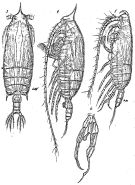 Issued from: G.O. Sars in Résult. Camp. Scient. Prince Albert I, 69, pls.1-127 (1924). [Pl.XVII, figs. 3-6]. Female: 3, habitus (dorsal); 4, idem (lateral left side). Male: 5, habitus (lateral left side); 6, P5.
|
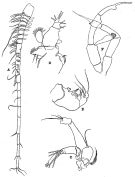 issued from : R.B.S. Sewell in The John Murray Expedition, 1933-34, Scientific Reports, VIII (1), 1947. [p.63, Fig.10, A, C-F]. As Gaetanus kruppi. Male (from Arabian Sea): A, A1; C, A2; D, Mx1; E, Mx2; F, P5. Nota: Proportional lengths of cephalothorax and abdomen as 75 to 25. The proportional lengths of the various segments (cephalon to caudal rami) as 540:71:65:75:42:74:48:42:10:32 = 1000. Head and 1st thoracic segment fused, 4th and 5th fused.
|
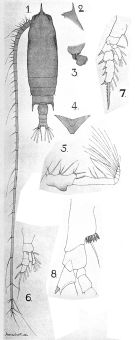 issued from : A. Scott in Siboga-Expedition, 1909, XIX a. [Plate VIII, Figs.9-15]. As Gaetanus caudani. Female (from Indonesia-Malaysia): 9, habitus (dorsal); 10, forehead (lateral); 11, last thoracic and genital segments (left side); 12, rostrum; 13, Mxp; 14, P1; 15, P4 (basal portion only). Nota: The lamella on the basal segment of Mxp is narrowed at the apex and deeply excavated. The posterior margin of the first three abdominal segments is fringed with fine spines.
|
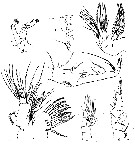 issued from : G.P. Farran in Scient. Invest. Fish. Brch, Ireland, 1901 (2), Appendix 7, 1903. [Plate XVII, Figs.3-8]. Female (from off Cleggan, Irelandl): 3, A2; 4, Md (cutting edge); 5, Mx2; 6, Mx1 (lower lobes omitted); 7, Mxp; 8, P1 (anterior); 8, P1 (anterior).
|
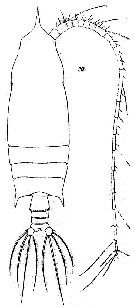 issued from : R.N. Wolfenden in J. mar. biol. Ass. U.K, 1904, VII (N.S.). [Pl.IX, Fig.20]. As Gaetanus caudani. Female (from NE Atlantic): 20, habitus (dorsal).
|
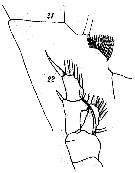 issued from : R.N. Wolfenden in J. mar. biol. Ass. U.K, 1904, VII (N.S.). [Pl.IX, Figs.21, 22]. As Gaetanus caudani. Female (from NE Atlantic): 21, basipod of P4; 22, P1.
|
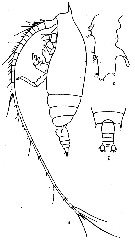 issued from : R.N. Wolfenden in Die Marinen Copepoden der Deutschen Südpolar-Expedition 1901-1903, 1911. [p.228, Fig.16].As Gaetanus recticornis. Female (from S Atlantic: off Trinidad Island): a, habitus (lateral, left side); b, posterior part cephalothorax and urosome; c, basal segment of Mxp.
|
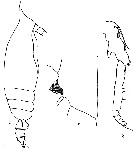 issued from : R.N. Wolfenden in Die Marinen Copepoden der Deutschen Südpolar-Expedition 1901-1903, 1911. [p.230, Fig.17]. As Gaetanus recticornisFemale: a, habitus (lateral, right side); b, Mxp; c, basipod of P4.
|
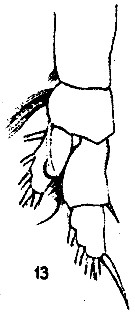 issued from : R.N. Wolfenden in Die Marinen Copepoden der Deutschen Südpolar-Expedition 1901-1903, 1911. [Pl.XXVI, Fig.13]. As Gaetanus recticornisFemale: 13, P1.
|
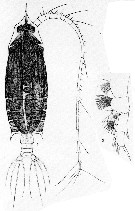 issued from : R.N. Wolfenden in Die Marinen Copepoden der Deutschen Südpolar-Expedition 1901-1903, 1911. [Pl.XXVII, Figs.1-2]. Female:1, habitus (dorsal); 2, P1.
|
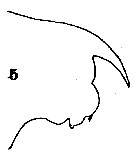 issued from : C.O. Esterly in Univ. Calif. Publs Zool., 1906, 3 (5). [Pl.9, Fig.5]. As Gaetanus clarus. Male (from San Diego, California): 5, forehead (lateral).
|
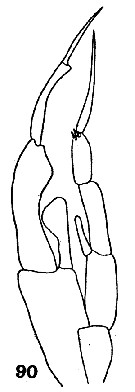 issued from : C.O. Esterly in Univ. Calif. Publs Zool., 1906, 3 (5). [Pl.14, Fig.90]. As Gaetanus clarus. Male: 90, P5 (right foot at left of figure).
|
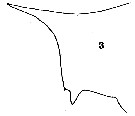 issued from : C.O. Esterly in Univ. Calif. Publs Zool., 1906, 3 (5). [Pl.9, Fig.3]. As Gaetanus unicornis. Female (from San Diego, California): 3, forehead (lateral). Nota: A1 24-segmentedreacing beyond the caudal rami by at least the last 4 segments.
|
 issued from : C.O. Esterly in Univ. Calif. Publs Zool., 1906, 3 (5). [Pl.12, Fig.54]. As Gaetanus unicornis. Female: 54, 1st basal of Mxp. The lamella on the 1st basal of Mxp is present, but does not have the rod-like extension of G. brevicornis or G. miles. Nota Nota: Exopod of P1 distinctly 2-segmented. 1st basal of P4 with tube-like bristles.
|
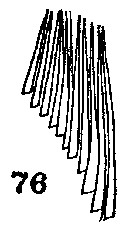 issued from : C.O. Esterly in Univ. Calif. Publs Zool., 1906, 3 (5). [Pl.13, Fig.76]. As Gaetanus unicornis. Female: distal portion of inner margin of 1st basal of P4.
|
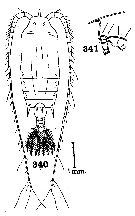 issued from : C.B. Wilson in Bull. U.S. natn. Mus., 1950, 100, 14 (4). [Pl. 23, Figs.340-341]. As Gaetanus recticornis. Female (from Pacific): 340, habitus (dorsal); 341, forehead (lateral).
|
 issued from : R.N. Wolfenden in Plankton Studies Part I. Copepoda. 1905 [Pl.III, 2]. As Gaetanus caudaniFemale: 2, habitus (lateral).
|
 Gaetanus pileatus Gaetanus pileatus female: 1 - Anterior part of cephalon with frontal spine. 2 - Exopodal segment 1 of A2 without seta; exopodal segment 2 with 1 seta (near distal margin). 2nd internal lobe of Mx1 with 4 setae. Exopod of P1 with 2 external spines. 3 - Mxp protopodite with lateral plate. 4 - Exopodal segment 2 of A2 with 1 seta. 5 - Spines of last thoracic segment exceeding at least the midlength of genital segment. Frontal spine large. 6 -, Frontal spine straight, not curved to rostrum by its top. 7 - Spines of last thoracic segment reaching third of genital segment length. External spine of exopodal segment 2 of P1 not reaching the midlength of the next segment.
|
 Gaetanus pileatus1 - Cephalon with frontal spine. Gaetanus pileatus1 - Cephalon with frontal spine.
2 - Exopodal segment 3 of left P5 prolonged, stylet-like, never bilobated. It is always longer than exopodal segment 2.
3 - Frontal spine is in anterior part of cephalon dorsally (lateral view), well visible.
4 - Spines on last thoracic segment significantly shorter than in G. simplex.
5 - Endopod of left P5 shorter than half length of exopodal segment 1.
| | | | | Ref. compl.: | | | Lysholm & al., 1945 (p.17); Sewell, 1948 (p.329, 500, 520, 529, 531, 539, 545, 556); C.B. Wilson, 1950 (p.233); Østvedt, 1955 (p.15: Table 3, p.63); Wickstead, 1962 (p.549, food & feeding); Grice & Hart, 1962 (p.287, table 3); Grice, 1963 a (p.495); De Decker & Mombeck, 1964 (p.12); Grice Hulsemann, 1965 (p.223); 1967 (p.15); 1968 (tab.2); Park, 1970 (p.476); Roe, 1972 (p.277, tabl.1, tabl.2); 1972 a (p.338); Bainbridge, 1972 (p.61, Appendix Table III: occurrence); Björnberg, 1973 (p.324, 386); Carter, 1977 (1978) (p.35); Deevey & Brooks, 1977 (p.256, tab.2, Station "S"); Pipe & Coombs, 1980 (p.223, figs. 1, 2, table 1, vertical distribution); Vives, 1982 (p.291); Roe, 1984 (p.357); Guangshan & Honglin, 1984 (p.118, tab.); Madhupratap & Haridas, 1986 (p.105, tab.1); Lozano Soldevilla & al., 1988 (p.58); Heinrich, 1990 (p.17); Baessa De Aguiar, 1991 (1993) (p.101); Lampitt & al., 1993 (p.689, faecal pellets v.s. ingestion); Shih & Young, 1995 (p.67); Errhif & al., 1997 (p.422); Padmavati & al., 1998 (p.347); Suarez-Morales & Gasca, 1998 a (p108); Lapernat, 2000 (tabl. 3, 4); Razouls & al., 2000 (p.343, Appendix); Madhupratap & al., 2001 (p. 1345, vertical distribution vs. O2, figs.4, 5: clusters, p.1353); d'Elbée, 2001(tabl. 1); Holmes, 2001 (p.49); Park, W & al., 2004 (p.464, tab.1); Gaard & al., 2008 (p.59, Table 1, N Mid-Atlantic Ridge); Galbraith, 2009 (pers. comm.); Park & Ferrari, 2009 (p.143, Table 5, Appendix 1, biogeography); Teuber & al., 2013 (p.1, Table 1, 2, abundance vs oxygen minimum zone, respiration rates); in CalCOFI regional list (MDO, Nov. 2013; M. Ohman, comm. pers.); Bode M. & al., 2013 (p.1, Table 1, respiration rate & ETS activity); Bonecker & a., 2014 (p.445, Table II: frequency, horizontal & vertical distributions, Table IV: new geographical record); Bode & al., 2015 (p.268, Table 1, chemical components, trophic level, geographic zone); Bode & al., 2018 (p.840, Table 1, respiration & ingestion rates, depth) | | | | NZ: | 20 | | |
|
Carte de distribution de Gaetanus pileatus par zones géographiques
|
| | | | | | | | | | | | 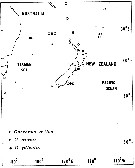 Issued from : J.M. Bradford & J.B. Jillett in New Zealand Ocean. Inst. Memoir, 86, 1980. [p.87, Figs.63]. Issued from : J.M. Bradford & J.B. Jillett in New Zealand Ocean. Inst. Memoir, 86, 1980. [p.87, Figs.63].
Distribution of several species of Gaetanus in the Tasman Sea and around New Zealand. |
 Issued from : M. Bode, R. Koppelmann, L. Teuber, W. Hagen & H. Auel inGlobal Biogeochemical Cycles, 2018, 32. [p.844, Table 1). Issued from : M. Bode, R. Koppelmann, L. Teuber, W. Hagen & H. Auel inGlobal Biogeochemical Cycles, 2018, 32. [p.844, Table 1).
Cf. explanations of these measures in Calanoides natalis from the same authors.
Compare with Gaetanus brevicornis, G. kruppii. |
 Issued from : M. Bode, A. Schukat, W. Hagen & H. Auel in J. Exp. Mar. Biol. Ecol., 2013, 444. [p.3, Table 1]. Issued from : M. Bode, A. Schukat, W. Hagen & H. Auel in J. Exp. Mar. Biol. Ecol., 2013, 444. [p.3, Table 1].
Dry mass, individual respiration rate and ETS activity from the northern Benguela Current upwelling system along transects at 23°S and 26°40'S, off Walvisbay and Lüderitz (Namibia). |
| | | | Loc: | | | sub-Antarct. (Indian, SE Pacif.), South Africa (E), off E Tristan da Cunha, Angola, Congo, off E Sao Tomé Is. Brazil (off Rio de Janeiro), G. of Guinea, off Lagos, Cape Verde Is., off Mauritania-NW Cape Verde Is., off Morocco-Mauritania, Canary Is., off Madeira, off Portugal, off W Cabo Finisterre, Azores, Barbada Is., Caribbean Sea, G. of Mexico, Florida, off Bermuda: Station "S" (32°10'N, 64°30'W), Sargasso Sea, W Ireland, Greenland, Iceland, Faroe Is., Norwegian Sea, Bay of Biscay, Arabian Sea, Laccadive Is., Natal, off SW Sri Lanka, Indian, S Indian (subtropical convergence), Indo-Malaysia, Philippines, China Seas (East China Sea, South China Sea), Japan (Izu), Pacif. (W equatorial), Australia (Great Barrier), New Zealand, Hawaii, Vancouver Is., California, off Galapagos, off Peru, Pacif. (SE tropical), off Juan Fernandez Is., Chile. Wyville Thomson Ridge (in Pipe & Coombs, 1980, Arctic).
Type locality: NE Atlantic (SW Ireland Slope). | | | | N: | 75 | | | | Lg.: | | | (1) F: 6,2; M: 4,7; (5) F: 6; (7) F: 5,74; (10) F: 5-4,6; (14) F: 6,1-5,9; M: 5,3-4,8; (17) F: 6,5; M: 5,3; (29) F: 4,1; (37) F: 6,7-4,9; M: 5,08-4,44; (38) F: 5,4-5,3; (40) F: 6,41-4,92; M: 5,08-4,44; (56) F: 6,14; (73) F: 5,82; (89) F: 5,93; (113) F: 6-5,5; (199) F: 6,56-5,55; M: 4,96-4,64; (201) F: 6,65-5,5; M: 4,85; 4,8; (249) F: 6,1-6; {F: 4,10-6,70; M: 4,44-5,30} | | | | Rem.: | méso-bathypélagique.
Sampling depth (sub-Antarct.) : 0-1000 m.
Signalé par Park, W & al. (2004) dans le Golfe d'Alaska (Icy Strait).
Voir aussi les remarques en anglais | | | Dernière mise à jour : 15/01/2021 | |
|
|
 Toute utilisation de ce site pour une publication sera mentionnée avec la référence suivante : Toute utilisation de ce site pour une publication sera mentionnée avec la référence suivante :
Razouls C., Desreumaux N., Kouwenberg J. et de Bovée F., 2005-2025. - Biodiversité des Copépodes planctoniques marins (morphologie, répartition géographique et données biologiques). Sorbonne Université, CNRS. Disponible sur http://copepodes.obs-banyuls.fr [Accédé le 04 décembre 2025] © copyright 2005-2025 Sorbonne Université, CNRS
|
|
 |
 |




























